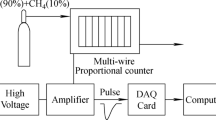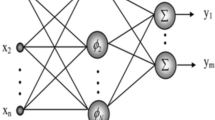Abstract
The rapid measurement of radon progeny concentration is of great significance for improving the efficiency of radon exposure dose evaluation in a specific area. In order to achieve rapid measurement of radon progeny concentration in engineering applications, this study is based on the rapid calculation function of BP (back propagation) neural network and uses other relevant environmental parameters to quickly obtain the radon progeny alpha potential energy. The relative standard uncertainty is 7.6% (k = 2), which met the uncertainty requirements of the standard of JJG (Military) 99-2015.The radon progeny alpha potential energy and its related parameters are substituted into the constructed neural network for training. According to the set training requirements, the range is set to 0–760 μJ/m3, and the simulation results meet the requirements of the "JJG (Military Industry) 99-2015" standard. The effect of rapid measurement can be achieved under the condition of ensuring measurement accuracy.







Similar content being viewed by others
References
El-Taher A et al (2013) Radon and its decay products in the main campus of Qassim University, Saudi Arabia, and its radiation hazards. J Am Sci 9(6):257–266
Bruenner S et al (2021) Radon daughter removal from PTFE surfaces and its application in liquid xenon detectors. Eur Phys J C 81(4):1–10
Hao S, Shi F (2019) Research and summary of radon measurement technology. Research on Key Technologies of Indoor Radiation Pollution Control and Improvement in Buildings, Shenzhen
Misdaq MA, Elouardi B, Ouguidi J (2017) 222Rn, 220Rn and their progenies measured in the air of different dwellings and workplaces and resulting alpha radiation doses to the eyes of individuals. Health Phys 113(5):363–374
Dinu AC et al (2017) Radon levels in Romanian caves: an occupational exposure survey. Environ Geochem Health 39(5):1085–1099
Liu X et al (2021) Deep multi-level fusion network for multi-source image pixel-wise classification. Knowl-Based Syst 221:106921
Chaipimonplin T (2016) Investigation internal parameters of neural network model for Flood Forecasting at Upper river Ping, Chiang Mai. KSCE J Civ Eng 20(1):478–484
Zhou C, Zhang Q, Jiang Y et al (2011) Evaluation of radioactive aerosols in nuclear accident monitoring. Nuclear Tech 34(11):866–871
Wang X, Shi F, Yu L, Li Y et al (2013) Analysis of 43 cases of MATLAB neural network. Beihang University Press, Beijing, pp 1–2
Ji C, Wang T, Zhang Q. Contrast between “five-stage method” and “three-stage method” for determining the concentration of 222Rn and 220Rn progeny. China Nuclear Control System Engineering, Beijing, 100176
Author information
Authors and Affiliations
Corresponding author
Additional information
Publisher's Note
Springer Nature remains neutral with regard to jurisdictional claims in published maps and institutional affiliations.
Rights and permissions
About this article
Cite this article
Cai, XM., Shan, J., Le, YL. et al. Rapid determination of radon progeny concentration based on artificial neural networks. J Radioanal Nucl Chem 330, 747–753 (2021). https://doi.org/10.1007/s10967-021-08002-5
Received:
Accepted:
Published:
Issue Date:
DOI: https://doi.org/10.1007/s10967-021-08002-5




